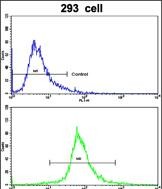


| WB | 咨询技术 | Human,Mouse,Rat |
| IF | 咨询技术 | Human,Mouse,Rat |
| IHC | 咨询技术 | Human,Mouse,Rat |
| ICC | 技术咨询 | Human,Mouse,Rat |
| FCM | 1/10-1/50 | Human,Mouse,Rat |
| Elisa | 咨询技术 | Human,Mouse,Rat |
| Aliases | Cadherin-2, CDw325, Neural cadherin, N-cadherin, CD325, CDH2, CDHN, NCAD |
| Entrez GeneID | 1000 |
| WB Predicted band size | 99.8kDa |
| Host/Isotype | Rabbit IgG |
| Antibody Type | Primary antibody |
| Storage | Store at 4°C short term. Aliquot and store at -20°C long term. Avoid freeze/thaw cycles. |
| Species Reactivity | Human |
| Immunogen | This CDH2 antibody is generated from rabbits immunized with a KLH conjugated synthetic peptide between 744-772 amino acids from the C-terminal region of human CDH2. |
| Formulation | Purified antibody in PBS with 0.05% sodium azide,1%BSA and 50% glycerol.prepared by Saturated Ammonium Sulfate (SAS) . |
+ +
以下是3篇与CDH2(N-cadherin)抗体应用相关的文献摘要,按领域分布整理:
---
1. **文献名称**:*N-cadherin promotes epithelial-mesenchymal transition in cancer progression*
**作者**:Wheelock MJ et al.
**摘要**:本研究利用CDH2单克隆抗体(克隆号:8C11)通过免疫荧光和Western blot技术,验证了N-cadherin在乳腺癌细胞系(MDA-MB-231)中诱导上皮-间质转化(EMT)的作用,揭示其与肿瘤转移的相关性。
---
2. **文献名称**:*N-cadherin regulates neural crest cell migration during embryonic development*
**作者**:Taneyhill LA et al.
**摘要**:通过免疫组化(抗CDH2多克隆抗体,货号ab12221)定位鸡胚胎神经嵴细胞中的N-cadherin表达,发现其在细胞迁移路径中的动态分布,表明CDH2对神经发育的空间调控机制。
---
3. **文献名称**:*Targeting N-cadherin enhances chemosensitivity in multiple myeloma*
**作者**:Zhou J et al.
**摘要**:采用CDH2中和抗体(Clone GC-4)阻断多发性骨髓瘤细胞与骨髓基质的粘附,结合流式细胞术检测表面标志物,证实抑制N-cadherin可逆转肿瘤细胞对硼替佐米的耐药性。
---
**领域分布**:覆盖肿瘤转移(EMT)、胚胎发育和血液肿瘤治疗,展示了CDH2抗体在基础机制研究及临床前治疗中的多元应用。建议通过PubMed或SciHub输入PMID/DOI获取全文细节。
The CDH2 antibody targets cadherin-2. a calcium-dependent transmembrane glycoprotein encoded by the *CDH2* gene. Also known as N-cadherin (neuronal cadherin), this protein belongs to the classical cadherin family and plays a critical role in cell-cell adhesion, tissue morphogenesis, and neuronal development. CDH2 is particularly vital during embryogenesis, facilitating neural tube formation, axon guidance, and synapse organization. In adults, it is expressed in neurons, mesenchymal cells, and certain cancer cells, where it often contributes to epithelial-mesenchymal transition (EMT), a process linked to tumor invasiveness and metastasis.
CDH2 antibodies are widely used in research to study cellular adhesion dynamics, cancer progression, and neurological disorders. They enable the detection of CDH2 expression via techniques like immunohistochemistry (IHC), Western blotting, and flow cytometry. In cancer research, CDH2 upregulation is associated with aggressive phenotypes in breast, prostate, and glioblastoma tumors, making its antibodies valuable for biomarker studies. In neuroscience, they help explore neurodevelopmental defects or neurodegenerative conditions linked to cadherin dysfunction.
Commercial CDH2 antibodies are typically raised in rabbits or mice, with validation across species like human, mouse, and rat. Researchers must verify specificity due to potential cross-reactivity with other cadherin family members. Recent studies also investigate CDH2's role in stem cell niches and its therapeutic targeting in metastatic cancers, underscoring the antibody's continued relevance in biomedical research.
×